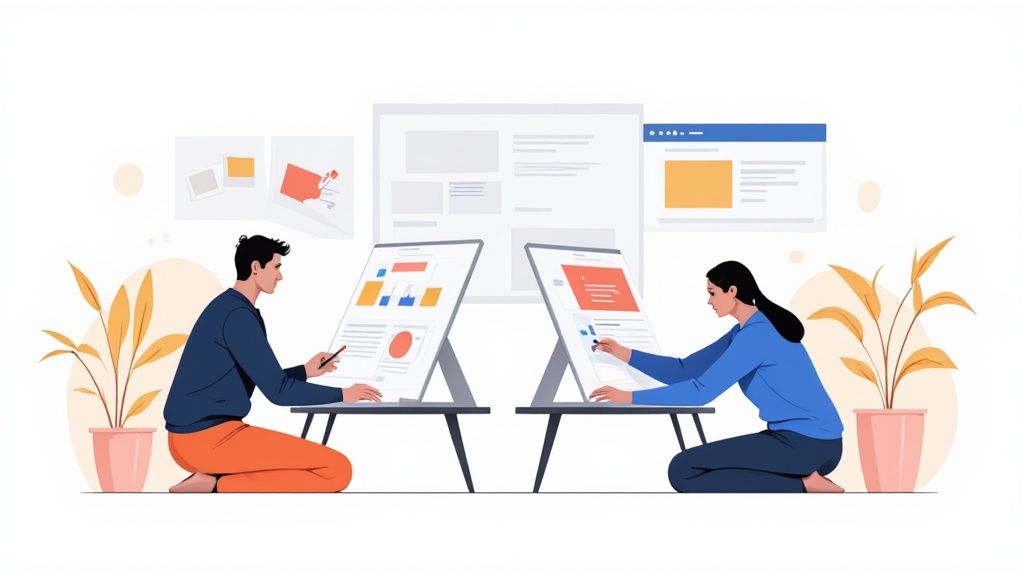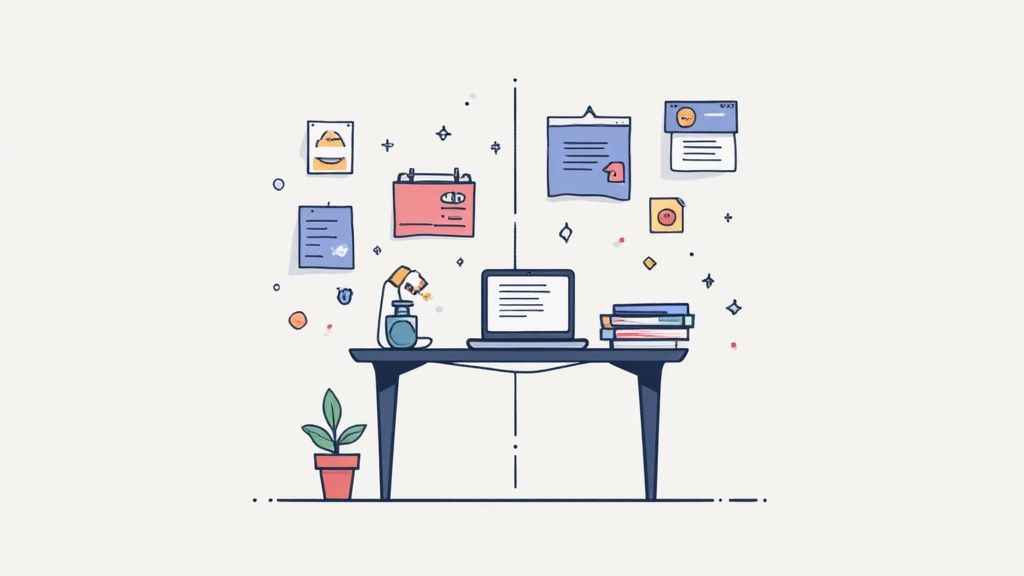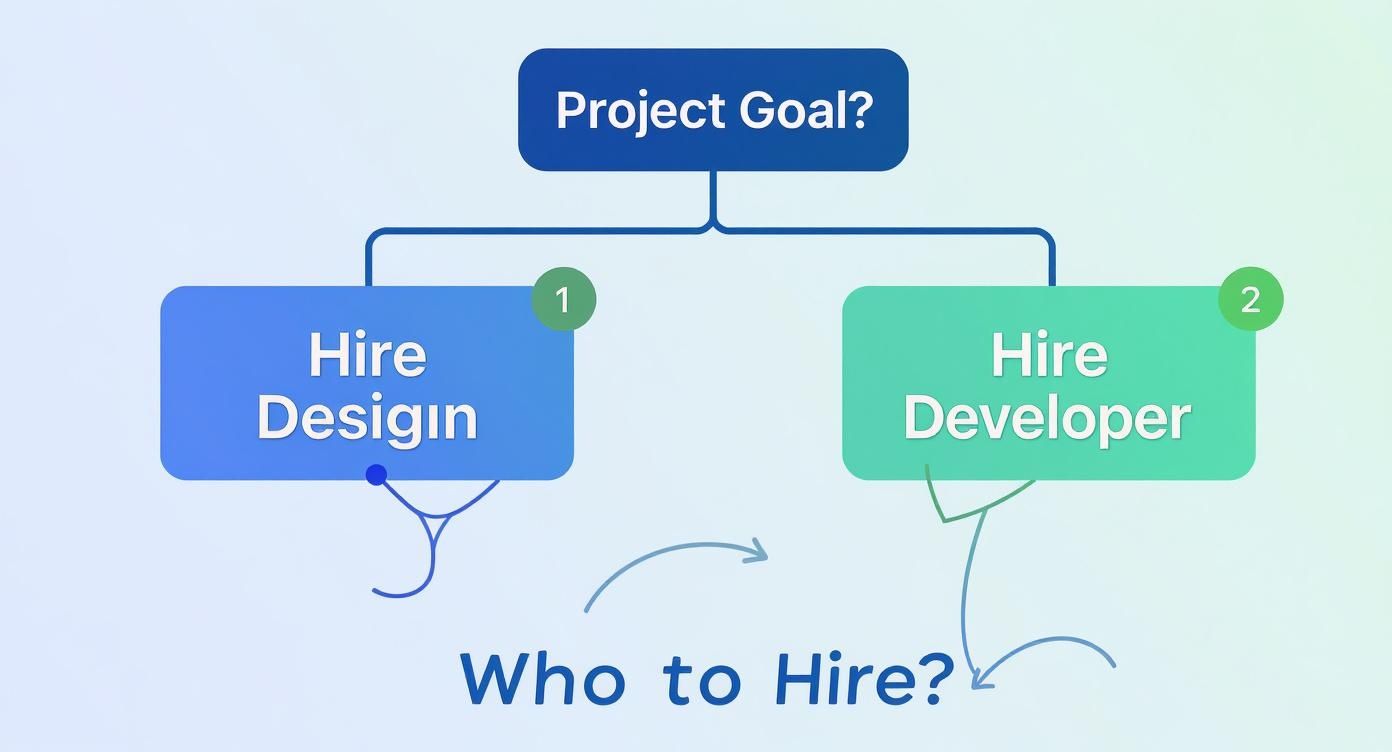It really boils down to this: A web designer is the architect, the one who obsesses over the look, feel, and user journey of a website.The web developer, on the other hand, is the engineer who brings that blueprint to life with code. Designers create the vision; developers build the functional reality. The Critical Difference: […]

It really boils down to this: A web designer is the architect, the one who obsesses over the look, feel, and user journey of a website.The web developer, on the other hand, is the engineer who brings that blueprint to life with code. Designers create the vision; developers build the functional reality.
To get a real-world feel for this, let's use the classic house-building analogy. The web designer is your architect. They draft the blueprints, figure out the best room layout for a natural flow, pick the color schemes, and make sure the whole place is both beautiful and a joy to live in.
The web developer is the construction team. They take those plans and pour the foundation, frame the walls, run the plumbing, and wire up the electricity. They make the house work.

These two roles demand completely different skills, tools, and frankly, different ways of thinking. A designer might spend their day deep in Figma or Sketch, crafting visual mockups and mapping out user pathways. A developer's world is code—they’re writing HTML, CSS, JavaScript, and maybe Python to make the design functional and interactive.
Sometimes a simple side-by-side view is the clearest way to see the divide. This table breaks down the core distinctions between the two roles.
| Aspect | Web Designer | Web Developer |
|---|---|---|
| Primary Focus | Visual aesthetics, user experience (UX), and user interface (UI) design. | Technical implementation, functionality, performance, and security. |
| Core Skills | Graphic design, wireframing, prototyping, color theory, typography. | HTML, CSS, JavaScript, PHP, Python, SQL, server management. |
| Key Tools | Figma, Sketch, Adobe XD, Photoshop, Illustrator. | VS Code, Git, GitHub, Command Line, various frameworks (React, Vue). |
| Main Goal | Create a website that is visually appealing, intuitive, and easy to navigate. | Build a technically sound, fast, and fully functional website. |
| Key Deliverable | Style guides, mockups, wireframes, interactive prototypes. | A live, coded, and functional website or web application. |
As you can see, the distinct responsibilities and skill sets also lead to a noticeable difference in compensation. With a broader technical scope that often includes both front-end and back-end programming, developers typically command a higher salary. The median annual salary in the US for a developer is around $73,186, compared to $47,554 for a designer.
Key Takeaway: You need both sides of the coin for a great website. A designer ensures your site connects with users and is a pleasure to use, while a developer guarantees it runs flawlessly and securely behind the scenes.
If you really want to dig into the nuances, exploring resources that detail the fundamental differences between web design and web development can provide even more clarity. This kind of foundational knowledge is what helps you pinpoint exactly which expert your project needs to truly succeed.
Sure, the textbook definitions give you a starting point, but the real difference between a web developer and a web designer comes to life in what they actually do all day. To plan a project and hire the right person, you need to understand their specific tasks and the tangible things they create. Each one owns a distinct phase of the project, and their output is the starting point for the next person in line.

Most of the time, a project kicks off with the web designer. Think of them as the advocate for your future users. Their daily work is all about understanding human behavior and turning those insights into a visual strategy that feels intuitive and looks great.
A web designer’s day is more about creative problem-solving and communication than it is about code. They get deep into the "why" and "how" of a user's journey long before anyone thinks about writing a single line of code.
Their process moves through a few key stages, each with a critical deliverable:
A designer's ultimate deliverable isn't just a pretty picture; it's a fully-realized, user-tested blueprint for the website's entire look, feel, and flow. This blueprint dictates what the developer must build.
As soon as the design prototype gets the green light, the web developer steps in. Their entire day revolves around turning that static visual plan into a living, functional website. This is where the team often splits into a few specialties.
Front-End Developers are the ones who build what you see. They take the designer's mockups and use languages like HTML, CSS, and JavaScript to construct the user-facing part of the site. Their main challenge is making sure the design looks and works perfectly on every browser and device.
Back-End Developers work on the machinery behind the scenes. They handle the server, database, and all the core logic that makes the website run. Using languages like Python, PHP, or Node.js, they build the engine that manages data, user accounts, and makes sure everything is fast and secure.
Full-Stack Developers are the versatile experts who are comfortable on both sides of the fence. They can handle a project from start to finish, from coding the user interface to managing the server. Their ability to see the whole picture is incredibly valuable, especially in smaller teams. You can learn more about how these different roles function within agile software development to better understand their collaborative dynamics.
Ultimately, a developer’s primary deliverable is a working website or application. This means writing clean code, integrating databases, setting up servers, and hunting down bugs. While a designer delivers the plan, a developer delivers the finished, functional product.
To hire the right person, you need to know exactly what skills and tools separate a web designer from a web developer. Think of it this way: one is the architect who dreams up the building, and the other is the engineer who makes sure it stands up. While they work toward the same goal, their day-to-day work, knowledge base, and software couldn't be more different.
Getting this right from the start is crucial. It means your job descriptions will attract the right talent and you won't end up with a brilliant coder when what you really needed was a visual strategist.
A web designer lives and breathes the user experience. Their world is visual, intuitive, and deeply rooted in understanding how people think and behave online. They blend artistic skill with a sharp, analytical mind to create digital experiences that feel effortless and look fantastic.
Their most critical skills include:
To bring these ideas to life, designers rely on a specific set of software.
A designer's true value lies not just in their mastery of tools like Figma or Sketch, but in their ability to empathize with the end-user. They build a visual and emotional bridge between your product and your audience before a single line of code is written.
Here are the go-to tools you’ll find in any modern designer’s workflow:
While the designer focuses on the look and feel, the developer is concerned with making it all work. Their job is to translate a static design into a living, breathing, functional website. This is where the web developer vs web designer distinction becomes crystal clear; one imagines the experience, the other builds it.
A developer's skills are often split into two main camps: the front-end and the back-end.
Front-end developers build everything you see and interact with in your browser. They are responsible for the client-side of the application, using the core languages of the web:
Back-end developers work behind the scenes on the server, database, and application logic. This is the engine that powers the website, handling things like user accounts, data processing, and security. Their toolkit includes:
Let's get straight to the bottom line: budgeting for your project. When you're weighing the costs of a web developer versus a web designer, you'll see a clear difference rooted in their distinct technical demands and what the market values. Getting a handle on these numbers is key to planning smart.
As a general rule, web developers come with a higher price tag than web designers, whether you're hiring full-time or for a freelance gig. The reason is simple: their work is inherently more complex. They’re the ones who take a beautiful design and breathe life into it with functional, secure code. This is especially true for back-end and full-stack developers, whose expertise in programming languages, databases, and server logic is a critical—and more costly—investment for any serious web application.
The pay gap shows up everywhere, from annual salaries to hourly freelance rates. A few things stir the pot here: years of experience, specific skills (like a niche programming language), and, of course, where in the world they're located.
In the United States, for example, the market puts a clear premium on technical skills. As of early 2025, you can expect a web developer to earn somewhere between $63,000 to $106,000 a year. Web designers, on the other hand, typically fall into the $50,000 to $91,000 range. The story is the same for freelancers, where developers often bill around $75 per hour, while designers are closer to $60 per hour. Keep in mind, a senior developer in a tech hub like San Francisco can easily pull in over $115,000. Location matters.
Key Takeaway: The higher price for a developer isn't arbitrary. It’s a direct reflection of the deep technical problem-solving needed to engineer a digital product. While a designer architects the experience, the developer builds the engine that makes it run.
To give you a clearer picture of how location plays into this, here’s a look at typical salary ranges across a few different tech hubs.
This table shows the typical salary ranges for web developers and web designers in different global tech hubs, illustrating the impact of location on compensation.
| Country/Region | Average Web Designer Salary (USD) | Average Web Developer Salary (USD) |
|---|---|---|
| United States | $50,000 – $91,000 | $63,000 – $106,000 |
| United Kingdom | $40,000 – $70,000 | $50,000 – $85,000 |
| Western Europe | $45,000 – $75,000 | $55,000 – $90,000 |
| Eastern Europe | $20,000 – $45,000 | $25,000 – $55,000 |
| India | $10,000 – $25,000 | $12,000 – $30,000 |
As you can see, tapping into global talent can dramatically change your budget, which is a strategic move for many businesses looking to manage costs effectively.
The specific needs of your project are what will truly shape your spending. A simple, static website has a completely different cost structure than a complex, feature-heavy web application.
Let's break it down with some real-world examples:
These examples show how the financial balance shifts from design to development as technical complexity grows. If you're looking to maximize your budget, exploring global talent is a smart move. It's worth digging into the details of offshore software development costs, as this approach can often lead to savings of 50-80% without compromising on quality.
Making the right hire at the right time is one of the most critical decisions you'll make. The choice between a web developer vs. a web designer isn't just about different skills; it’s about matching the right expertise to your project's immediate goals. Get it wrong, and you're looking at costly delays and a product that just doesn't hit the mark.
The most important question to ask yourself is this: "What is the core problem I need to solve right now?" Are you trying to define a visual identity and map out how a user will navigate your product from the ground up? Or are you ready to build a functional piece of software based on an already-approved plan? Your answer points directly to whether you need the architect (designer) or the engineer (developer) first.
This simple decision tree can help you focus on your primary goal.

As you can see, if aesthetics and user experience are the top priority, you start with a designer. But if functionality is what's driving the project forward, a developer is your immediate need.
For most new projects, bringing a web designer on board first is the standard playbook for a reason. Their work creates the essential foundation that guides all the technical development to come, which prevents a ton of expensive code revisions down the road. A design-first approach is all about making sure you're building something people will actually want to use.
You should prioritize hiring a designer in these situations:
Key Insight: Hiring a designer first is really an investment in reducing risk. A well-researched, user-tested prototype validates your idea and gives your development team a clear blueprint, making sure your money is spent building the right thing.
While it's less common for projects starting from zero, there are definitely times when hiring a web developer first makes the most sense. This usually happens when the visual direction is already locked in or the challenge is purely technical. A developer's job is to turn those plans into a functional, secure, and high-performing reality.
Here’s when a developer should be your first call:
For complex projects like launching a SaaS product or a major e-commerce platform, the "web developer vs. web designer" debate is a non-starter. You don't choose one or the other—you need a collaborative team.
In these cases, a designer architects the user experience while front-end and back-end developers work together to bring it to life. The cost of this dual expertise is significant, reflecting not just the complexity of the project but also the market demand for this kind of specialized talent. For instance, web developer salaries can range from $5,000 in a market like India to $88,000 on average in the United States, and can easily top $135,000 for senior roles in tech hubs like Seattle. You can explore a detailed breakdown of how much web developers earn to get a better handle on budgeting for these critical roles.
Knowing the difference between a web developer and a web designer is the easy part. Actually finding and hiring the right person for your project? That's where the real challenge begins. A solid plan, however, can turn that uncertainty into a confident hiring decision.
This framework breaks down the essential steps, from sizing up portfolios to asking questions that get to the heart of a candidate's skills. The first step is just knowing what to look for. Think of it this way: a designer’s portfolio tells a story of creative problem-solving, while a developer’s is a showcase of technical execution.
When you’re looking at a designer's work, you need to see past the pretty pictures. A truly great portfolio isn't a gallery; it’s a collection of case studies that reveal their thought process and, most importantly, the results they delivered.
A developer’s portfolio is, by nature, less visual and much more technical. You'll be digging into their code quality, how they approach problems, and their command of the specific technologies you need.
A developer’s GitHub profile is often more revealing than their resume. Clean, well-documented code and contributions to open-source projects demonstrate not only technical skill but also a passion for their craft and collaborative spirit.
Here’s a quick checklist for what to look for:
Once you have a shortlist, the interview is your chance to go deeper. The key is to tailor your questions to the role you're actually hiring for.
Questions for a Web Designer:
Questions for a Web Developer:
For a deeper dive into the practicalities of expanding your team, including strategies for talent acquisition, explore this comprehensive guide on how to hire remote developers. Platforms that pre-vet talent can dramatically simplify this entire process. For example, HireDevelopers.com provides access to the top 1% of global engineers, handling the screening so you can focus on finding the perfect fit. If you're considering building a larger team, understanding the benefits of outsourcing custom software development can also provide valuable context for your hiring strategy.
Even with a detailed comparison, you probably still have a few lingering questions. Let's tackle some of the most common ones that come up when people are trying to decide between hiring a web developer or a web designer.
It happens, but it's rare to find someone who is truly an expert in both. The roles really are that different. A dedicated web designer lives and breathes user experience (UX) and visual theory—things most developers simply don't have the time or inclination to master. Their entire job revolves around understanding how people think and creating a visual path that feels natural.
If the user experience is a top priority for your project, you'll get a much better result by hiring separate specialists. You might occasionally come across a "hybrid" professional, often called a UI/UX Engineer, who has a solid grasp of both design fundamentals and front-end code. They can be a great bridge between the two worlds.
For a new digital product, nine times out of ten, you should hire a UX/UI designer first. Before you write a single line of code, the designer will validate your entire business idea. They'll do the critical upfront work: user research, mapping out customer journeys, and building wireframes and interactive prototypes.
This "design-first" approach is a game-changer. It makes sure you're building something people actually need and will enjoy using before you sink a ton of money into development. Finalizing a design based on real feedback can easily save you thousands in development costs down the line.
Think of it this way: the designer creates the blueprint, and the developer builds the house. You wouldn't build without a blueprint.
Strictly speaking, no. But knowing the basics of HTML and CSS is a massive advantage for any web designer. This knowledge ensures their designs are actually buildable and helps them have much more productive conversations with the development team.
When a designer understands the technical constraints, it closes the gap between the visual concept and the final product. It prevents them from creating a beautiful design that's a nightmare (or just plain impossible) for a developer to implement.
A full-stack developer is like a jack-of-all-trades in the engineering world. They're comfortable working on both the front-end (what the user sees) and the back-end (the server, database, and application logic). They can handle the entire technology stack from top to bottom.
But don't mistake them for a designer. While they are incredibly valuable for their wide-ranging technical skills, their expertise is in building functional systems. They aren't focused on the user-centric, psychological principles of design that are a web designer's bread and butter.
A work style assessment is a tool designed to show you how a candidate naturally gets things done. It peels back the curtain on the way they communicate, tackle problems, and interact with colleagues in a real-world work setting. It's not about what they know, but about how they operate. Understanding a Candidate's Professional DNA […]

The global talent landscape has shifted. For CTOs and engineering managers, finding top-tier software developers locally is slower, more expensive, and more competitive than ever. Nearshore software development, partnering with expert teams in similar time zones, has emerged not just as a cost-cutting measure, but as a powerful strategic advantage. It offers the perfect blend […]

The classic 9-to-5 developer gig isn't the only game in town anymore. If you're looking for more flexibility, a side income, or even just a foot in the door of the tech industry, software developer part time jobs are a fantastic—and increasingly common—path forward. The Growing Reality of Part Time Software Development Let's be real: […]
